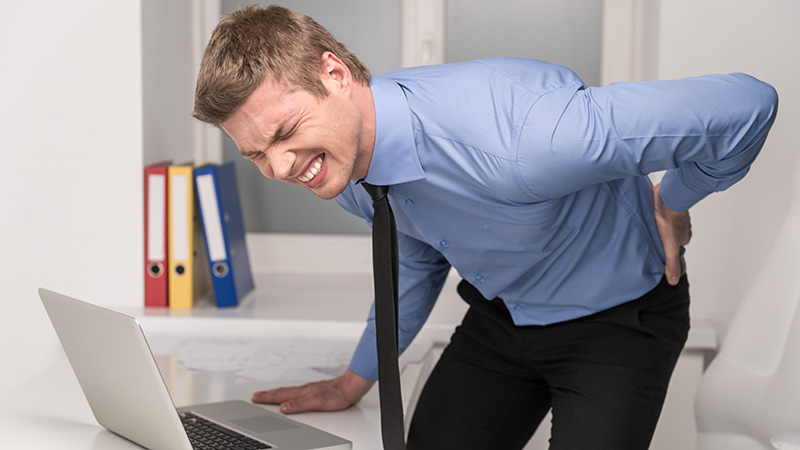That Annoying Ache in Your Lower Back…
You’re halfway through your workday. Your shoulders are tight, your lower back is throbbing, and your legs feel like they’ve forgotten how to move. Sound familiar?
Maybe someone at work swears by their standing desk. Or maybe you’ve seen those sleek setups online and wondered if standing is the secret to a pain-free back.
But here’s the big question: Do standing desks actually help with back pain — or are they just another expensive fad?
Let’s break it down honestly — the pros, the cons, the science, and what real people experience.
✅ Key Takeaways
-
Standing desks can relieve some types of back pain, especially from prolonged sitting.
-
But standing too long can cause different pain (legs, feet, lower back).
-
The secret? Movement — not just standing still.
-
The best setups let you switch between sitting and standing throughout the day.
-
Posture, desk height, and footwear all matter.
The Sitting Problem: Why Our Backs Hate Office Chairs
Let’s start with what’s really causing your back pain.
We weren’t built to sit for 8+ hours a day. And when we do, here’s what happens:
-
Your hip flexors tighten, pulling on your lower back.
-
Your spine compresses, especially without lumbar support.
-
Your core shuts off, which means your back muscles take all the strain.
-
Blood flow slows down. Muscles stiffen. Pain builds.
According to the Mayo Clinic, sitting for long stretches is linked to a host of health problems — from weight gain to poor posture to, yes, chronic back pain.
So it makes sense that standing would help… right?
So… Do Standing Desks Help With Back Pain?
The Short Answer?
Yes, but only if used the right way.
A 2019 study published in the BMJ found that workers who used sit-stand desks reported less back discomfort and higher energy during the day.
But here’s the kicker — people who just stood all day without moving didn’t feel much better. Some even developed new aches, like in the feet, knees, or lower spine.
Let’s look at why.
Standing Still Isn’t a Miracle Cure
It turns out, standing still is just as unnatural as sitting still.
When you’re locked into one posture — whether it’s hunched over your laptop or stiff at a standing desk — your body suffers. Muscles fatigue. Joints ache. Circulation slows.
People often make these common mistakes when switching to a standing desk:
-
Standing too long too soon (start with 15-30 minutes at a time)
-
Poor footwear (heels or hard-soled shoes)
-
Incorrect desk or monitor height
-
Leaning on one leg (causes imbalances)
A standing desk isn’t a silver bullet. It’s just a tool. The magic happens when you use it to add variety and movement to your day.
The Real Fix: Movement and Variety
Your body craves movement.
You don’t need to be jogging around the office — just shifting positions regularly makes a huge difference.
Here’s a realistic approach:
Try the “Sit-Stand-Switch” Method:
-
Sit for 30–45 minutes
-
Stand for 15–30 minutes
-
Walk or stretch for 5 minutes
-
Repeat
You’re not aiming to be upright all day. You’re aiming for postural diversity — mixing it up.
According to Harvard Health, alternating between sitting and standing can help reduce back pain, boost energy, and even improve focus.
What Kind of Standing Desk Is Best?
1. Manual Sit-Stand Converters
Cheap. Sits on top of your current desk. Good for beginners.
2. Electric Adjustable Desks
More expensive, but smooth height changes and better posture options.
3. Fixed Standing Desks
Not recommended. You can’t sit, so you’re stuck in one position — which defeats the purpose.
Pro Tip: If budget is tight, a stack of sturdy books and a laptop stand can be your starter kit. What matters most is how often you switch positions, not how fancy the desk is.
But What About Back Pain While Standing?
Standing can relieve sitting-related back pain — but if your posture or desk setup is off, it can create new issues.
Watch out for these pain triggers:
-
Arching your lower back too much (posterior tilt)
-
Locking your knees (circulation slows, muscles fatigue)
-
Forward head posture (especially if your monitor is too low)
-
Unsupported arms (shoulders fatigue fast)
Standing Desk Ergonomics 101
Let’s keep it simple. Whether you’re sitting or standing:
-
Elbows: at a 90-degree angle
-
Monitor: top of the screen at eye level
-
Wrists: straight, not bent
-
Feet: flat on the ground (or on a footrest/mat)
-
Shoulders: relaxed, not hunched
Invest in:
-
A cushioned anti-fatigue mat
-
Supportive shoes (no heels!)
-
A monitor riser or adjustable arm
A few tweaks can turn an uncomfortable setup into a back-friendly workstation.
What Real People Say
Jen, 38 — Graphic Designer
“My lower back pain used to kick in by noon. I switched to a standing desk last year, but honestly, I stood too long at first. Now I alternate every hour, and my pain has gone down a lot.”
Marcus, 44 — Software Engineer
“I didn’t want to buy anything, so I stacked books under my keyboard. Worked fine! The key for me was walking around every hour. That helped more than standing alone.”
Priya, 29 — Teacher (Remote)
“I got a cheap converter on Amazon and use a kitchen timer to remind me to stand. It’s been a game-changer for my posture.”
Should You Get a Standing Desk?
Ask yourself:
-
Do you sit more than 6 hours a day?
-
Do you have recurring neck or back pain?
-
Do you forget to take movement breaks?
-
Do you feel stiff or sluggish during work?
If you said yes to most of those… a standing desk might be worth trying.
But again — standing alone won’t fix it.
It’s about posture, movement, and habits.
Are Standing Desks Worth It?
Yes — when used the right way.
They’re not a cure-all, but they’re a powerful tool to reduce sitting time, fight back pain, and feel more energized.
If you can commit to switching positions regularly, improving your posture, and staying mindful of your body, a standing desk can genuinely make your workday less painful.
You don’t need to go all-in. Start small. Test what works for you. Your back will thank you.
🙋 FAQ: Standing Desks & Back Pain
1. Can standing desks cure back pain?
No. They can help relieve some types of back pain, especially from prolonged sitting, but they’re not a cure.
2. How long should I stand at a standing desk?
Start with 15–30 minutes at a time, a few times per day. Gradually increase as your body adjusts.
3. Can standing desks cause lower back pain?
Yes, if used incorrectly — poor posture, standing too long, or using the wrong height can lead to discomfort.
4. Is it better to sit or stand at work?
Neither is “better” — it’s the alternating that matters. Too much of either causes problems.
5. Do I need an expensive standing desk to get benefits?
Nope. Even a stack of books or a budget converter can work. It’s about movement, not money.
6. What shoes should I wear at a standing desk?
Comfortable, supportive shoes with a soft sole. Avoid heels or unsupportive flats.
7. What’s the best posture for standing at a desk?
Stand tall, weight evenly balanced, arms at 90 degrees, and screen at eye level.
8. Can I use a standing desk all day?
Not recommended. Switch between sitting and standing every 30–60 minutes.
9. Do anti-fatigue mats really help?
Yes. They reduce pressure on your joints and encourage micro-movements.
10. What’s the best time to use a standing desk?
Try standing after meals, during meetings, or when you feel sluggish — times when you’d otherwise feel tired or stiff.
🔗 Credible Sources
Ready to stand up to your back pain — literally?
Even small changes to your daily routine can shift the way your body feels. Want more real-life fixes for everyday pain and productivity struggles? Check out more insights on Upvolta.com — your body and brain will thank you.


